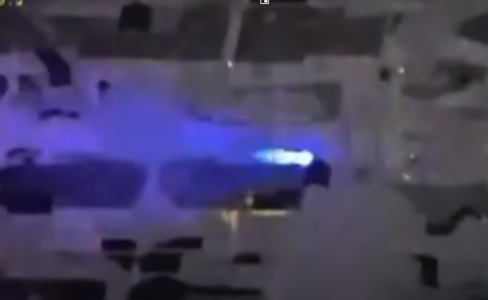Authorities charge man with impairing pilot’s vision from his home
By
Gian T
- Replies 7
In a strange and alarming event that has left many stunned, a resident has been arrested for using a bright light to target an aircraft.
What appeared to be a simple gesture could potentially result in severe legal consequences, including a lengthy prison sentence for the individual.
Authorities have warned that such actions pose serious risks to aviation safety.
On a Friday, the 58-year-old man was apprehended on his front lawn in Salisbury at around 7:30 pm.
The arrest followed a report from a pilot who had been flying overhead.
The pilot's alert to the authorities was prompted by a 'bright light' that had been intentionally directed at his aircraft.
The light severely affected his visibility and potentially endangered the safety of everyone on board.
Upon arrival at the scene, police officers claim to have caught the man in the act, red-handed, as he aimed the light towards the plane from his Copas Drive residence.
Subsequent searches of the property revealed the high-powered torch and a Taser.
The charges laid against the man are severe: prejudice to the safe operation of an aircraft and possession of a dangerous article.
These offenses carry a maximum combined jail sentence of 15 years and six months.
The accused was granted bail and is scheduled to appear at Elizabeth Magistrates Court on 16 May.
The Australian Civil Aviation Authority has been apparent about the risks of lasers and high-intensity lights.
Such devices can be significantly dangerous to pilots, leading to difficulties in flying and impaired vision.
The authority warns that these lights only take a fraction of a second to cause flash blindness or ocular damage, even if the aircraft moves at speed.
This incident is not an isolated one in South Australia. In November 2020, Mark Andrew Golka, a 49-year-old from Woodcroft, was arrested for shining a laser 2000 times the legal strength at a police helicopter during Covid-19 compliance checks.
Although Golka received a suspended sentence after pleading guilty, the SA District Court Chief Judge, Michael Evans, emphasised that his actions could have had 'catastrophic consequences.'
Our members, mainly those interested in aviation or law, might find this story alarming.
It serves as a stark reminder of the profound legal implications that can arise from what some might consider a harmless prank.
The safety of those in the air and on the ground is paramount, and the law reflects the gravity of actions that compromise it.
In other news, a man has been charged with allegedly disrupting Melbourne Airport's aviation radio networks by broadcasting chants and false mayday calls.
The Australian Federal Police launched an investigation, arresting a 45-year-old from Lower Plenty in north-east Melbourne. You can read more about it here.

Have you ever witnessed or heard of similar occurrences in your community? What do you think about the potential punishment for the crime? Join the conversation below.
What appeared to be a simple gesture could potentially result in severe legal consequences, including a lengthy prison sentence for the individual.
Authorities have warned that such actions pose serious risks to aviation safety.
On a Friday, the 58-year-old man was apprehended on his front lawn in Salisbury at around 7:30 pm.
The arrest followed a report from a pilot who had been flying overhead.
The pilot's alert to the authorities was prompted by a 'bright light' that had been intentionally directed at his aircraft.
The light severely affected his visibility and potentially endangered the safety of everyone on board.
Upon arrival at the scene, police officers claim to have caught the man in the act, red-handed, as he aimed the light towards the plane from his Copas Drive residence.
Subsequent searches of the property revealed the high-powered torch and a Taser.
The charges laid against the man are severe: prejudice to the safe operation of an aircraft and possession of a dangerous article.
These offenses carry a maximum combined jail sentence of 15 years and six months.
The accused was granted bail and is scheduled to appear at Elizabeth Magistrates Court on 16 May.
The Australian Civil Aviation Authority has been apparent about the risks of lasers and high-intensity lights.
Such devices can be significantly dangerous to pilots, leading to difficulties in flying and impaired vision.
The authority warns that these lights only take a fraction of a second to cause flash blindness or ocular damage, even if the aircraft moves at speed.
This incident is not an isolated one in South Australia. In November 2020, Mark Andrew Golka, a 49-year-old from Woodcroft, was arrested for shining a laser 2000 times the legal strength at a police helicopter during Covid-19 compliance checks.
Although Golka received a suspended sentence after pleading guilty, the SA District Court Chief Judge, Michael Evans, emphasised that his actions could have had 'catastrophic consequences.'
Our members, mainly those interested in aviation or law, might find this story alarming.
It serves as a stark reminder of the profound legal implications that can arise from what some might consider a harmless prank.
The safety of those in the air and on the ground is paramount, and the law reflects the gravity of actions that compromise it.
In other news, a man has been charged with allegedly disrupting Melbourne Airport's aviation radio networks by broadcasting chants and false mayday calls.
The Australian Federal Police launched an investigation, arresting a 45-year-old from Lower Plenty in north-east Melbourne. You can read more about it here.
Key Takeaways
- An Adelaide man has been arrested for allegedly shining a high-powered torch at an aircraft, which impaired the pilot's vision.
- He faced charges that could result in more than 15 years of imprisonment.
- The man was arrested after a pilot reported the incident to authorities, leading to his apprehension on his front lawn.
- Shining lasers or high-intensity lights at aircraft is a serious offence because it can cause flash blindness or ocular damage to pilots, posing a threat to aviation safety.
Last edited:








